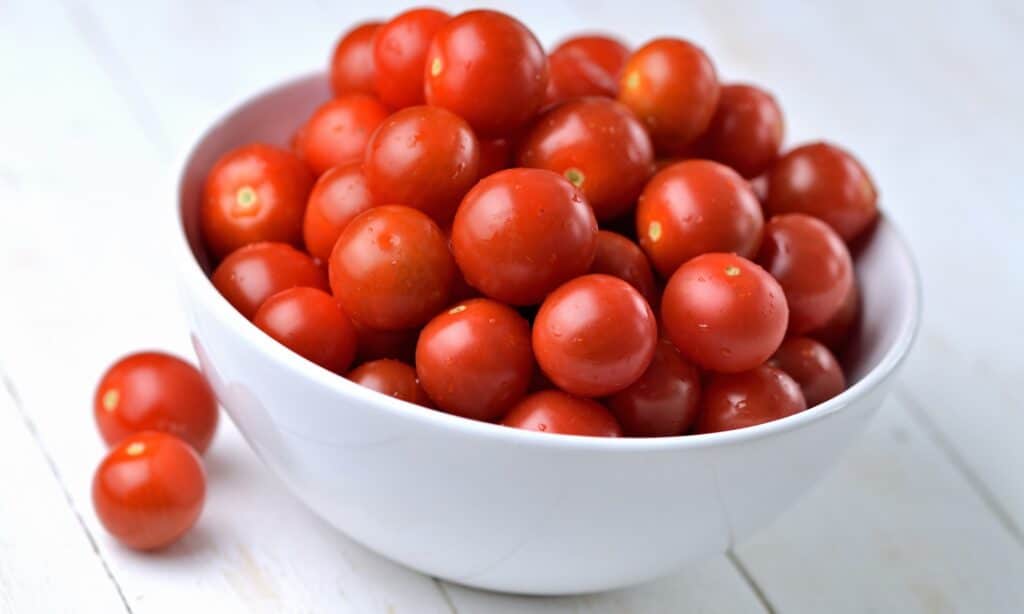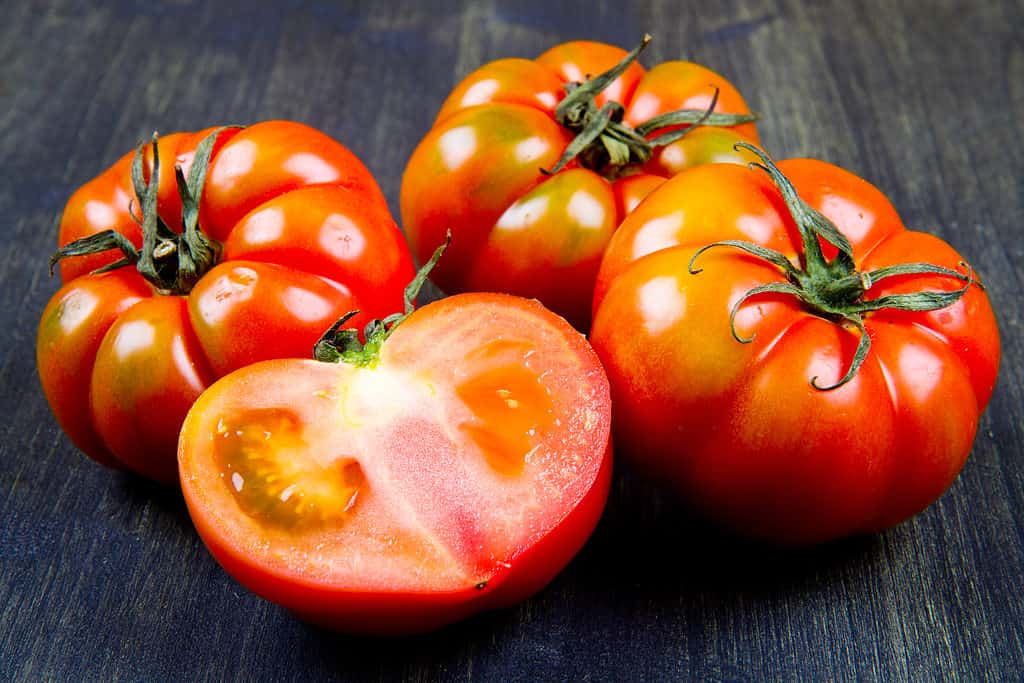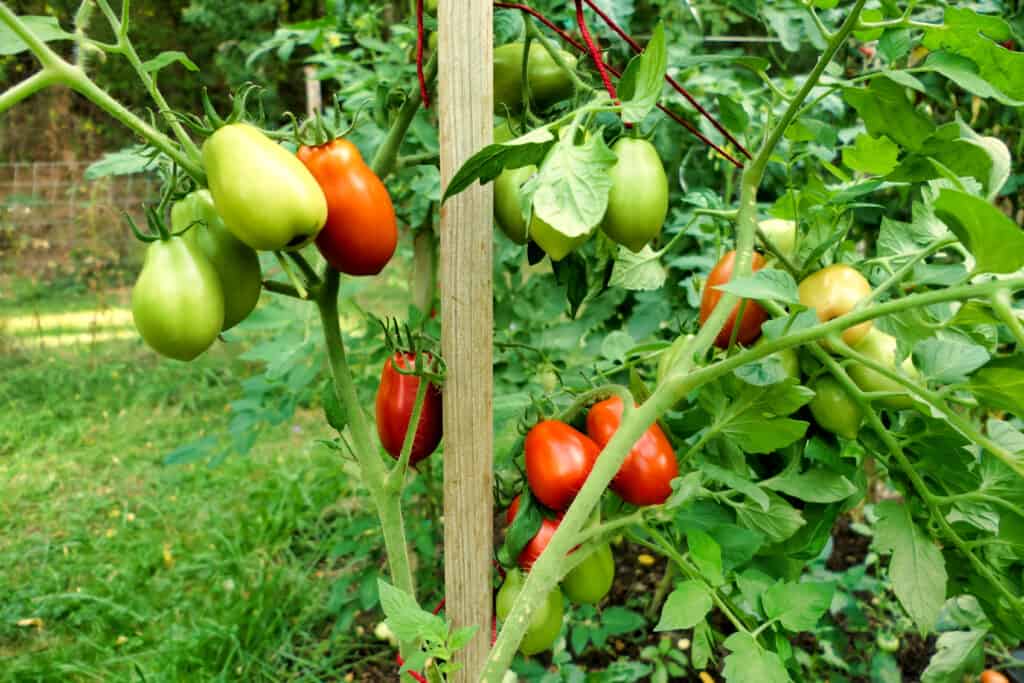Sandwiches, salsas, pasta sauce, and ketchup all highlight the flavorful tomato. These tasty fruits (yes, they’re technically a fruit!) are easy to grow in home gardens. They’re easy to cultivate, versatile in the kitchen, and there are countless varieties to choose from. Now that spring is in full swing, with summer peeking around the corner, it is the perfect time to start planning your next tomato garden.
Below, we will highlight nine different types of tomatoes that you should consider planting this spring. From classic heirloom varieties to unique, eye-catching options, there’s something for every taste and need. So, without further ado, it’s time to make your mouth water.

Grow your own cherry tomatoes for excellent snacking!
©iStock.com/CobraCZ
1. Beefsteak
The enormous beefsteak tomatoes are one of the most popular varieties of slicing tomatoes. They’re large and meaty, making them perfect for sandwiches. And their juicy, sweet flavor adds a nice touch to any salad. Even better — beefsteak tomatoes are the ideal base for salsas. You can find this variety in many colors, including red, pink, orange, and even purple.
Depending on the variety, this group of tomatoes is either indeterminate or determinate plants. Indeterminate varieties will continue to grow and produce fruit throughout the season, making them the better choice for your tomato-loving family. However, if you hope to can or preserve your tomatoes, opt for determinate plants. These will produce all of their fruit at once, making your preservation job easier.
2. Roma
This group is well-known as the classic paste tomato and is also known as plum tomatoes. They are a popular base for sauces, soups, and stews. Their dense, meaty flesh holds up well to extended processing and cooking. Plus, they come with a rich, tangy flavor that makes for a mouth-watering pasta sauce. Roma tomatoes are typically a deep red color and have an elongated shape.
Roma tomatoes are a determinate variety, so they’ll produce all their fruit at once. That is one of the reasons they are such a popular choice for canning and making sauces. You could also slice them up for salads, sandwiches, or BLTs. Or consider dicing them up for taco toppings. They do have some juice, but not enough to make your delicious taco soggy.
3. Cherry
You simply cannot go wrong with cherry tomatoes. They are essentially the “jack of all trades” in the family. These small, bite-sized tomatoes can be used for just about any application you can dream of. Grill them, skewer them, pop them in your mouth whole, add them to salads, or cut them up and top them with balsamic vinegar and pepper.
Cherry tomatoes are a versatile variety that can be grown on both indeterminate and determinate plants. They come in many colors, from bright red to yellow and even black. So you can find a color and flavor profile that best suits your tastes. Plus, they have an irresistibly sweet flavor that will make it hard to stop eating them.
4. San Marzano
These tomatoes originate in Italy and are plum tomatoes. They are quite famous for their prominence in Italian cooking. They are low-acid, making them the ideal addition to pasta sauces or pasta dishes in general. Additionally, they have a slightly sweet, pleasing flavor and meaty flesh. San Marzanos are typically a deep red color and have a cylindrical shape.
San Marzanos are a determinate tomato, so it is easy to harvest for bulk sauce production or canning. If some tomatoes show up a little early before the rest of the fruit, you can toss them in the freezer to keep (that is, of course, if you can resist eating the early harvest).
5. Brandywine
This classic heirloom variety has a sweet, juicy flavor and dense, meaty flesh. The large tomatoes often weigh around one pound. And they have a slightly flattened shape. You can find Brandywine tomatoes in red, pink, or yellow.
6. Cherokee Purple
This spectacular heirloom variety boasts a deep purple-red color and a sweet, slightly smoky flavor. The meaty tomatoes have dense flesh, making them perfect for slicing and adding to sandwiches or salads. Cherokee Purples also make a unique addition to sauces or salsas.
7. Green Zebra
As the name hints, green zebra tomatoes have a yellow and green striped look. They are slightly tart and tangy. Their bright, fresh flavor is ideal for adding to salads or using as a garnish.
8. Yellow Pear
These lovely fruits are small and teardrop-shaped. They have a very mild flavor profile with a hint of sweetness. And as their name suggests, they have a bright yellow color. These are the perfect tomato for snacking or topping salads with. And their unique shape makes them stand out on any plate.
9. Black Krim
This is a truly unique heirloom variety. It is well-known for its dark purple-red color and sweet, slightly smoky flavor. These tomatoes are large and have dense, meaty flesh. They are perfect for slicing to add to sandwiches or salads. Black Krims are also great for roasting or grilling since their dense flesh holds up well. But even better… The slightly smoky taste only gets enhanced further after the fruit gets heated.

Beefsteak tomatoes are large, often weighing a pound or more, and make the perfect sandwich slices.
©Luca Santilli/Shutterstock.com
Growing Tips
Growing this popular fruit can feel a little intimidating. But don’t worry. Tomatoes are actually much easier to grow and care for than many think. However, there are a few things to keep in mind.
First, make sure you choose tomatoes well-suited to your growing conditions. For example, if you live in a hot and humid climate, you may want to pick a variety resistant to diseases like blight and wilt. While seeds from major companies are convenient and easy to source, they aren’t necessarily ideal for your growing conditions. Consider seeking a local seed company that carries tomato seeds. Alternatively, if you opt for starter plants, your local nursery will carry varieties best suited for your climate.
Second, make sure you give your plants plenty of sunlight and water. Tomatoes love the sun and need at least six hours of direct sunlight daily. That sun is particularly important if you live in a humid environment, as it will help dry off the leaves and prevent diseases from catching hold of your plants. Your plants will need to get watered deeply once or twice a week. How often will truly depend on your climate. The best method is to bottom water. When tomato leaves get too much moisture, diseases are more apt to develop.
Third, make sure you give your tomatoes plenty of space to grow. Indeterminate varieties can grow up to 8 feet tall and 3 feet wide, so they will need ample room to spread out or climb. Determinate varieties, on the other hand, are more compact and typically only grow to about 3 or 4 feet tall. You will also need to provide growing support, which is our next tip.
Fourth, make sure you provide support for your tomato plants. Indeterminate varieties should get staked or trellised to keep them from sprawling on the ground. However, determinate varieties can usually get supported with a cage or stakes. Select the method that is most appropriate for your garden and your plants.
Fifth, make sure you fertilize your tomato plants regularly. Tomatoes are heavy feeders and need plenty of nutrients to grow and produce fruit. Start with organic compost and then add a balanced fertilizer throughout the growing season. There are tomato-specific fertilizers on the market. You can speak with your local nursery if you have any questions about the best products.
Finally, make sure you harvest your tomatoes at the right time. Most varieties will be ready to harvest when they’re fully ripe and have a deep color. However, some, like San Marzano, are best when they’re slightly underripe, as they’ll have a firmer texture and less juice.

Stake your tomatoes to help support them as they grow.
©iStock.com/PlazacCameraman
The photo featured at the top of this post is © Teri Virbickis/Shutterstock.com
Thank you for reading! Have some feedback for us? Contact the AZ Animals editorial team.







